Mauna Loa carbon dioxide forecast for 2025
Atmospheric CO2 rise now exceeding IPCC 1.5°C scenarios
Richard A. Betts, Chris D. Jones, Ralph Keeling, Jeff R. Knight, James O. Pope and Caroline Sandford
Following the fastest annual rise in atmospheric carbon dioxide concentration in the Mauna Loa record between 2023 and 2024, the increase between 2024 and 2025 is forecast to remain faster than that required to track IPCC scenarios that limit global warming to 1.5°C. The ongoing CO2 rise is driven by fossil fuel burning and land use change, but the increase this year will be smaller than last year due to a re-strengthening of natural carbon sinks partly linked to a shift from El Niño to emerging La Niña conditions. Despite this, the annual CO2 rise will be too high to be compatible with the IPCC’s 1.5°C scenarios.
We forecast the annual average CO2 concentration at Mauna Loa, Hawaii to be 2.26 ± 0.56 parts per million (ppm) higher in 2025 than in 2024. As a result, we forecast the 2025 annual average CO2 concentration at Mauna Loa to be 426.6 ± 0.6 ppm (Figure 1). This will continue the ongoing rising trend in CO2 seen in the long-term record of measurements from the Mauna Loa observatory in Hawaii that date back to 1958 (also known as the Keeling Curve). The Mauna Loa record is usually a good guide to rise in global average CO2 concentration, which we therefore expect to increase by a similar amount.
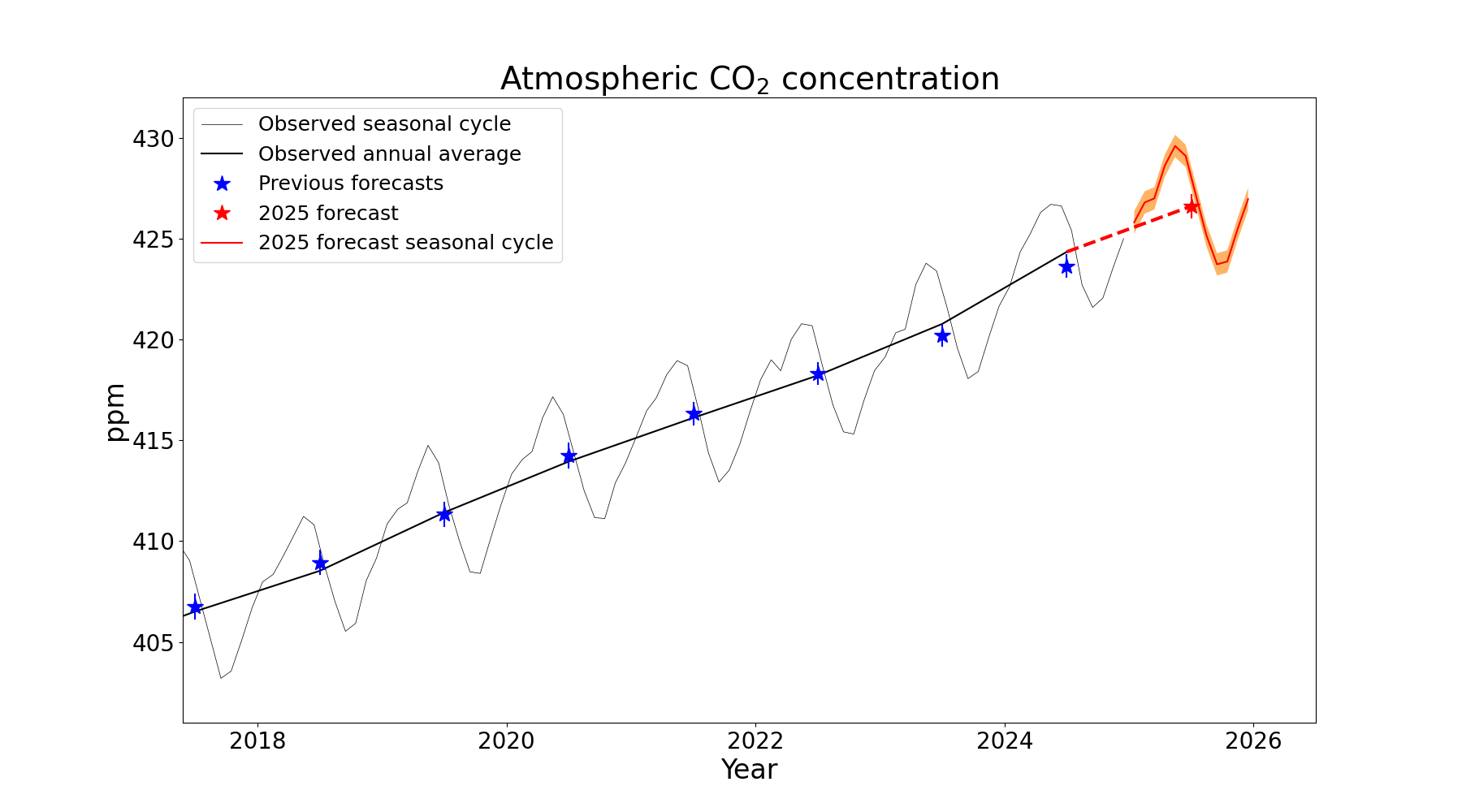
Figure 1. Forecast CO2 concentrations at the Mauna Loa observatory, showing monthly (red curve) and annual (red star) values. The orange band and vertical red line shows the forecast uncertainty ranges. The thin and thick black curves show the observed monthly and annual average concentrations respectively. Blue stars and blue lines show previous forecast annual averages and their uncertainties, with the 2020 value being the updated 2020 forecast issued followed the reduction in global CO2 emissions due to the Covid-19 pandemic. Observed data is from the Scripps Institution of Oceanography, UC San Diego.
The size of the annual CO2 rise has generally been increasing but with substantial variation from year-to-year (Figure 2), with the increase from 2023 to 2024 being the largest on record.
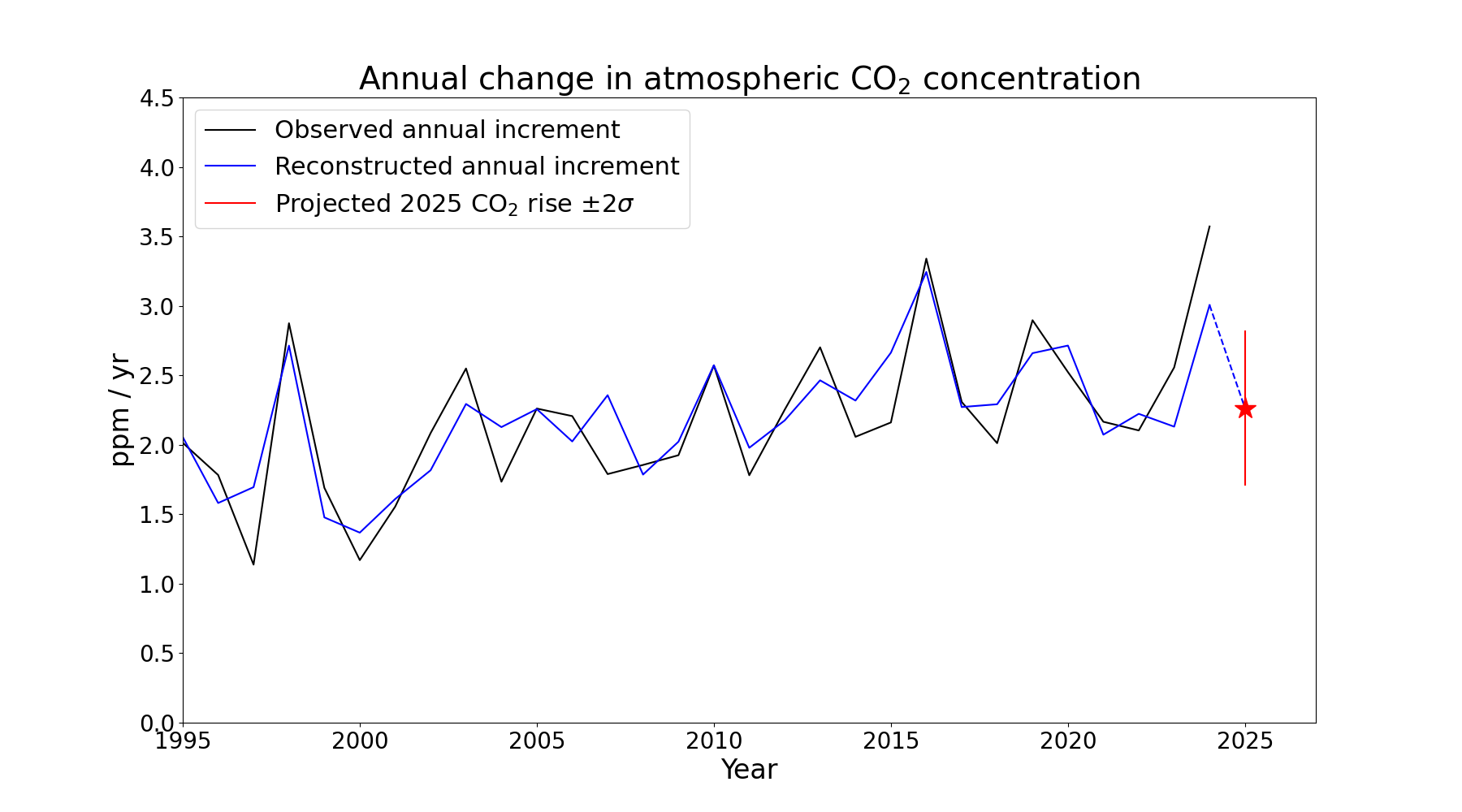
Figure 2. Annual increments in CO2 concentration at the Mauna Loa observatory from observations (black) and the 2025 forecast (red star). The forecast uncertainty range (red line) is ± 2 standard deviations. The blue line shows statistical reconstructions of past annual CO2 increments using the same method as used in the forecast. Observations are from the Scripps Institution of Oceanography, UC San Diego.
Contributions of anthropogenic emissions and varying natural carbon sinks to the CO2 rise
Long-term increases in observed CO2 are the result of human-caused emissions of carbon dioxide into the atmosphere – more than enough CO2 has been emitted by fossil fuel burning and deforestation to account for the increase measured in the atmosphere. Although CO2 concentrations have now increased by over 50% since the industrial revolution, this increase would have been almost twice as large if some CO2 had not been removed from the atmosphere through natural absorption by plants and the oceans.
These natural sinks of carbon vary in strength from year to year due to short-term fluctuations in climate, principally linked to El Niño Southern Oscillation (ENSO) cycles in the tropical Pacific Ocean but with other aspects of climate variability also having effects. This means that although emissions are increasing relatively smoothly, the rate of CO2 increase in the atmosphere shows more variability due to the varying strength of natural carbon sinks. El Niño conditions typically lead to a faster annual CO2 rise, due to an overall weakening of natural carbon sinks, largely driven by hotter, drier conditions in tropical land areas. La Niña conditions have broadly opposite impacts, so typically lead to an overall strengthening of natural carbon sinks and hence a slower annual CO2 rise. The Met Office CO2 forecast takes account of both anthropogenic emissions and the impacts of ENSO-related climate variability on natural carbon sinks, accounting for the latter using the observed correlation between the annual CO2 rise and sea surface temperatures (SSTs) in the equatorial Pacific Ocean (Figure 3). With ENSO currently close to La Niña thresholds, we expect a temporary strengthening of carbon sinks and hence a slightly smaller rise in atmospheric CO2 than would have been the case without this.
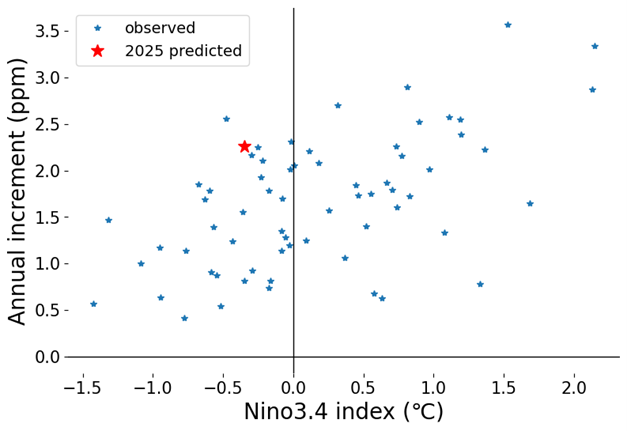
Figure 3. Annual CO2 growth rate for years 1960 to 2023 and predicted for 2025 relative to the preceding year, vs. the Niño3.4 index for April of the preceding year to March of the current year. The Niño3.4 index is the sea surface temperature (SST) anomaly in region 5°N to 5°S and 170°W to 120°W in the Pacific Ocean, de-trended to remove the effect of long-term warming.
For short periods such as individual years, the observed rate of build-up of CO2 in the atmosphere does not necessarily reflect changes in emissions – the effects of climate variability on the short-term rise can dominate. However, in the longer term, the ongoing increase in the annual rate of CO2 rise is quite evident despite large interannual variability (Figure 4). When the effects of ENSO are removed, the calculated CO2 rise shows an ongoing increase, but with the rate of increase slowing rate around 2012 due to the slowing of the rise in global emissions. There was also a temporary slowing of the ENSO-adjusted CO2 rise in 2020 due to the reduction in global emissions following worldwide reductions in transport and energy production to the COVID-19 pandemic.
Impact of El Niño on the forecast CO2 rise in 2025
We can estimate the potential contribution of emerging La Niña conditions to the CO2 rise forecast for 2025 by repeating our forecast calculation without the sea surface temperature change, ie: with "neutral" conditions. This suggests that without a La Niña response in the atmosphere and tropical land ecosystems, the forecast annual mean CO2 rise from 2024 to 2025 would be 2.41 ppm, a slightly faster rise than the 2.26 ppm forecast when accounting for La Niña (Figure 4).
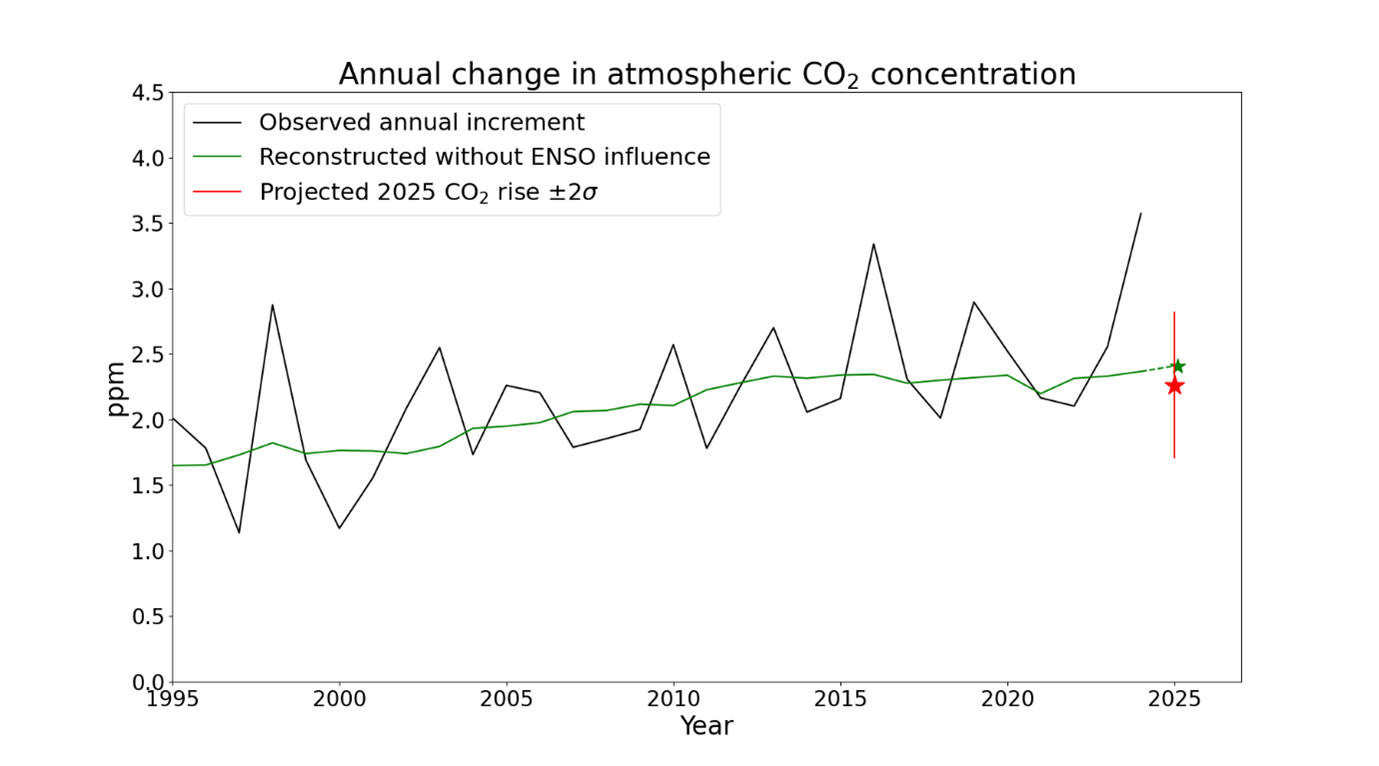
Figure 4: Annual increments in CO2 concentration at the Mauna Loa observatory from observations (black) and the 2025 forecast (red star), and the estimated increments without the influence of ENSO (green line and green star). The forecast uncertainty range (red line) is ± 2 standard deviations. Observations are from the Scripps Institution of Oceanography, UC San Diego.
Comparison with previous annual CO2 increments
The average annual CO2 rise has increased over the 6 decades of the Mauna Loa record (Table 1), due to ongoing rise in human-caused emissions which once again reached a new record high in 2024. In addition, regional climate conditions linked partly to El Niño caused a substantially weaker uptake of carbon by global land during 2024, resulting in a CO2 rise of 3.58 ppm between 2023 and 2024, the largest increase between calendar years in the 67-year Mauna Loa record (Figure 5).
The forecast rise of 2.26 ± 0.56 ppm for 2024-25 is smaller than last year due to the movement from El Niño towards La Niña conditions, and is predicted be the 12th largest on record, with an uncertainty range of between the 5th and 33rd largest.
Table 1. Decadal average annual CO2 rises in the Mauna Loa record
|
Decade |
Average CO2 rise (ppm per year) |
|
1960s |
0.86 |
|
1970s |
1.22 |
|
1980s |
1.58 |
|
1990s |
1.55 |
|
2000s |
1.91 |
|
2010s |
2.41 |
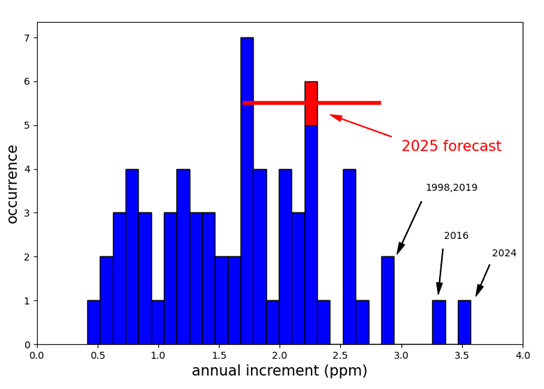
Figure 5. The central estimate of the forecast annual CO2 increment for 2024-2025 in the context of the frequency distribution of the observed annual increment for each year in the Mauna Loa record. The horizontal red bar shows the forecast uncertainty range of ± 0.56 ppm.
Comparison with CO2 trajectory consistent with limiting global warming to 1.5°C
The Paris Agreement commits nations to pursuing efforts to limit the rise in global temperatures to 1.5°C above pre-industrial levels. In modelled scenarios that achieve this, the rise in atmospheric CO2 slows rapidly and ceases completely within the next two decades. The IPCC 6th Assessment Report included 3 scenarios which have at least a 50% likelihood of limiting global warming to 1.5°C with little or no overshoot (Table 2). The C1-IMP-LD scenario features efficient resource use and changing consumption patterns leading to low demand for resources; C1-IMP-REN focusses on renewables; and C1-IMP-SP illustrates shifting global pathways towards sustainable development. Other scenarios could also be followed, but all would require the rise in CO2 to slow to zero urgently for global warming to be limited to 1.5°C, unless interventions such as solar radiation modification were assumed.
Table 2. Decadal average CO2 rises in three illustrative scenarios limiting global warming to 1.5° with little or no overshoot (IPCC 2022).
|
Decade |
Average CO2 rise (ppm per year) |
||
|
C1-IMP-LD |
C1-IMP-REN |
C1-IMP-SP |
|
|
2020s |
1.33 |
1.75 |
1.79 |
|
2030s |
-0.14 |
0.13 |
0.57 |
|
2040s |
-0.53 |
-0.46 |
-0.07 |
|
2050s |
-0.65 |
-0.61 |
-0.41 |
The IPCC scenarios can provide a benchmark against which the observed and forecast atmospheric CO2 rise can be compared as part of assessing progress towards the Paris Agreement goal. Figure 6 makes this comparison with the C1-IMP-SP scenario, which is the least ambitious of the three scenarios in the near term, allowing for the largest CO2 rise in the 2020s. Last year's record rise in CO2 concentration was well above even this scenario. Even without the additional effects of natural climate variability (green line in Figure 6), we estimate that the 2023-2024 CO2 rise would have been at the upper limit of the uncertainty range for the 1.5°C-compatible scenario.
The central estimate of the forecast rise for 2024-2025 (red star) remains above the rate required to track the 1.5°C-compatible scenario, despite being considerably smaller than last year. If the rise were to be at the lower end of the uncertainty range (vertical red line) then it would align with the 1.5°C scenario, but without the effects of climate variability (green star) the 2025 rise would be further above the 1.5°C scenario.
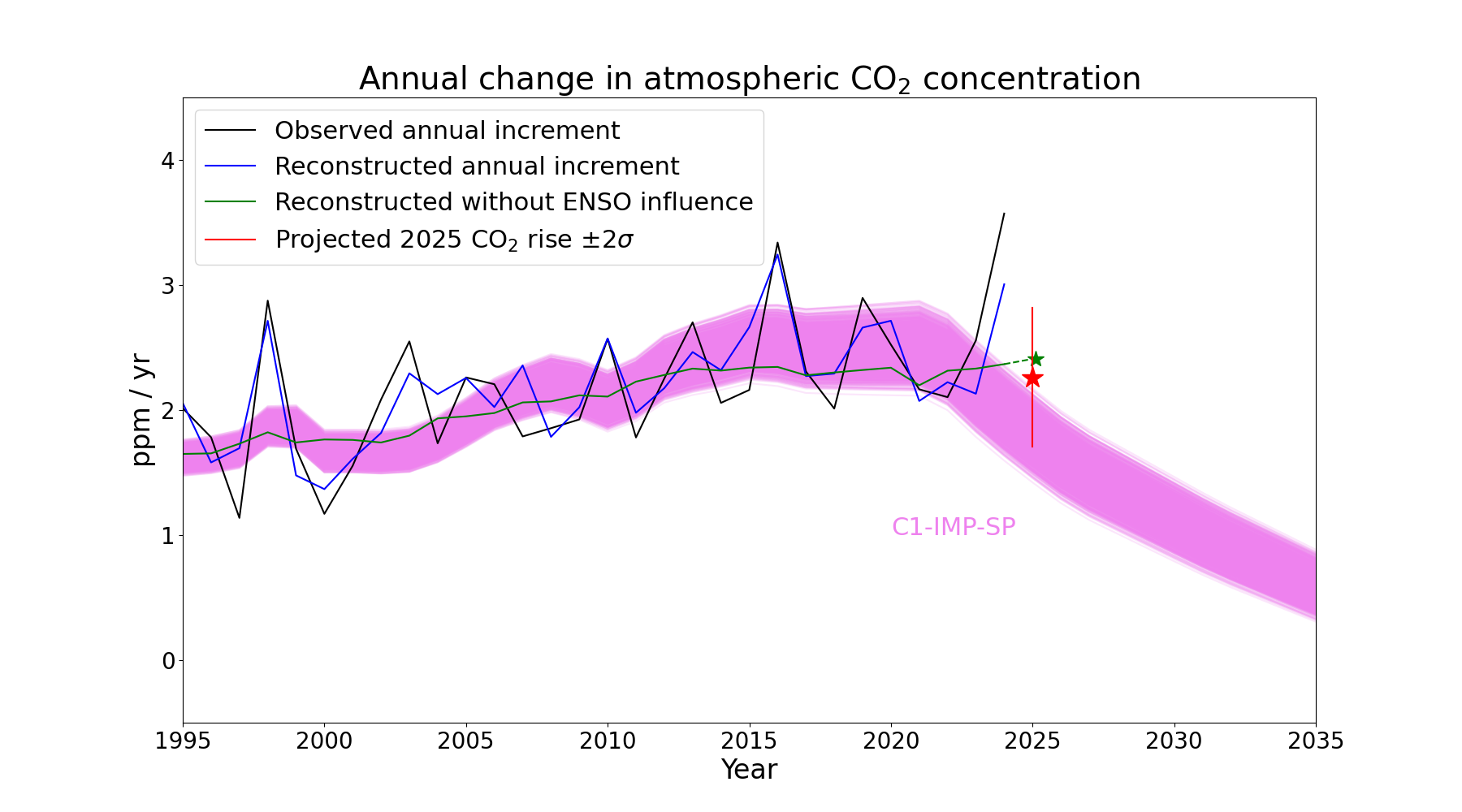
Figure 6. Comparison of recent and forecast annual CO2 increments with an illustrative scenario limiting global warming to 1.5°C. Black line: Annual increments in CO2 concentration at the Mauna Loa observatory from observations. Blue line: Annual increments in CO2 concentration at the Mauna Loa observatory reconstructed using a statistical relationship between concentrations, emissions and ENSO. Red star with vertical error bars: the 2025 forecast increment. Green line and green star: Estimated increments without the influence of ENSO. Purple plume: simulated CO2 concentrations in the C1-IMP-SP scenario limiting global warming to 1.5°C with >50% likelihood.
If atmospheric CO2 concentrations were to follow the “shifting pathways” scenario limiting global warming to 1.5°C, the average annual CO2 rise over the 2020s would need to be approximately half of that seen between 2023 and 2024 and 80% of that forecast for 2025. This would only be achievable by immediate and substantial cuts in global CO2 emissions. To track the 1.5°C scenario, global emissions in 2025 would need to be reduced by approximately 20% to 9 GtC / yr, and continue to be reduced further year-on-year.
The speed with which the CO2 rise needs to slow for global warming to be limited to 1.5°C can be further put into context by extending the Keeling Curve with projected concentrations from an illustrative 1.5°C-compatible scenario (Figure 7). The observed rise from 2023 to 2024 is already tracking above the 1.5°C scenario, and the gap is predicted to increase in 2025.
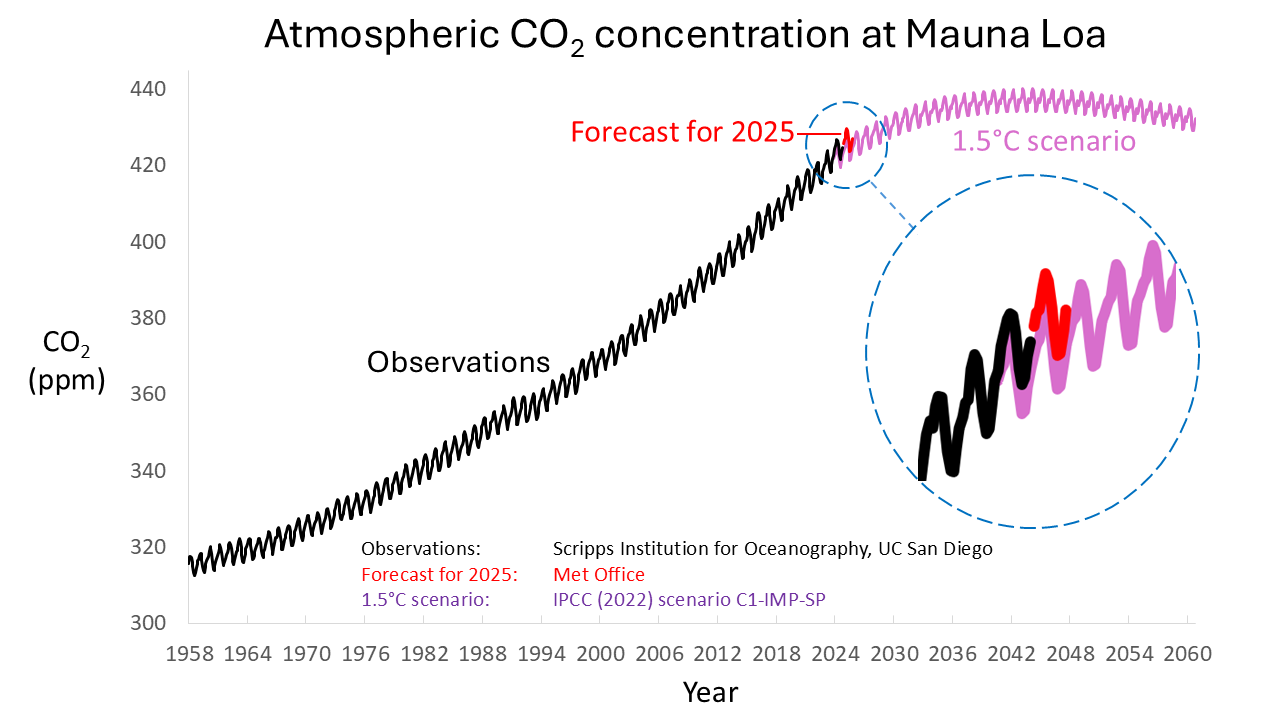
Figure 7. Monthly CO2 concentrations from observations up to 2024 (black) and a scenario consistent with limiting global warming to 1.5°C (purple). Also shown is the Met Office forecast for 2025. Observations are the Keeling Curve record at Mauna Loa, from the Scripps Institution for Oceanography, UC San Diego, which began in March 1958. From 2024 onwards, monthly values are calculated from the annual mean concentrations in the C1-IMP-SP scenario, with an illustrative seasonal cycle imposed which continues the amplitude seen in recent years.
Seasonal cycle of CO2 concentrations
We also predict the maximum and minimum monthly values in the seasonal cycle of CO2 concentrations at Mauna Loa (Figure 1, Table 3). Each year, the CO2 value at Mauna Loa increases in the first 5 months, peaks in or around May, then declines for the next 4 months due to the uptake of CO2 by land ecosystems in the northern hemisphere growing season. Following a minimum, which is usually in September, atmospheric CO2 then increases again as autumn and winter leaf-fall and decay cause a release of CO2 back to the atmosphere. In 2025, we predict this seasonal cycle to peak at a monthly mean value of 429.6 ± 0.6 ppm in May (Figure 1, Table 3). From comparison with reconstructions of past CO2 levels from isotopes of carbon and boron in marine sediments, this will be the highest atmospheric CO2 concentration for over 2 million years. CO2 will then return to a minimum monthly value of 423.7 ± 0.6 ppm in September before rising again.
Methods
The technique used to make this forecast was also used to make forecasts ahead of time for 2016, 2017, 2018, 2019, 2020, 2021, 2022, 2023 and 2024. In 2020 we also issued an updated forecast once it became clear that the response to the Covid-19 pandemic would cause global CO2 emissions to be much smaller than expected that year.
Table 3. Forecast monthly average CO2 concentrations at Mauna Loa in 2025. The 2 standard deviations uncertainty is ± 0.6 ppm
|
Month |
Forecast CO2 concentration (ppm) |
|
January |
425.8 |
|
February |
426.8 |
|
March |
427.0 |
|
April |
428.6 |
|
May |
429.6 |
|
June |
429.1 |
|
July |
427.2 |
|
August |
425.2 |
|
September |
423.7 |
|
October |
423.9 |
|
November |
425.5 |
|
December |
427.0 |
Our usual methodology uses a statistical relationship between the annual CO2 rise, human-caused emissions and changes in sea surface temperature (SST) in the equatorial Pacific Ocean as a measure of the strength of the dominant pattern of natural climate variability that is known to affect the strength of carbon sinks. We use an average of SSTs from ocean observations in recent months and seasonal forecasts for the coming months. Previous work found that the CO2 increment between 2 consecutive calendar years correlates most strongly with the SSTs in the 12 months from April to March within those 2 years.
For most years from 2016 to 2023, our forecast calculations used the annual emissions from the previous year as published in the Global Carbon Budget, as normally the ongoing trend in emissions is not large enough to affect the forecast substantially. Our original forecast for 2020 also made this assumption, while our revised 2020 forecast included an adjustment based on projected emissions profiles across the year applied to an atmospheric transport model. Our forecast for 2021 assumed that global emissions had returned to approximately 2019 levels, having already returned to near those levels at the end of 2020. Our forecast for 2022 used the fossil fuel emissions for 2019 and land use emissions from 2020. Our forecasts for 2023, 2024 and 2025 returned to the usual method of using Global Carbon Budget emissions from the previous year.
In our forecast we assign the same uncertainty to monthly and annual values, but this ignores the role of within-year impacts such as periods of fire activity in areas not typically affected by ENSO, or anomalous wind directions at the measurement site at Mauna Loa. Quantification of these additional sources of uncertainty at monthly levels are a topic of ongoing research and our stated uncertainty on the monthly averages will therefore be an underestimate.
Verification of the 2024 CO2 forecast and discussion
The observed CO2 rise of 3.58 ppm between 2023 and 2024 at Mauna Loa was larger than our forecast of 2.84 ± 0.54 ppm, despite the forecast having accounted for the effects of the 2023-2024 El Niño event. The observed monthly concentrations were higher than the central estimate of the forecast for every month except January, and above the upper end of the uncertainty range for 8 months (Figure 8, Table 4).
Although both fossil fuel and land use change emissions are both expected to have increased slightly in 2024 compared to 2023, the combined increase of about 0.2 GtC is not enough to explain the larger-than-predicted rise in CO2 concentrations. The ocean carbon sink is expected to have been slightly stronger (0.1 GtC) than in 2023. However, there were widespread fires in both North and South America, including in regions not normally affected by El Niño such as Canada, and extending beyond the season of El Niño influence in South America.
Global fire emissions were estimated as 1.6-2.2 GtC yr-1 during January-September 2024, 11-32% above the 2014-2023 average for the same months (1.5-1.7 GtC yr-1). A portion of these fire emissions may already be accounted for in the land use emissions estimate, but it is not possible to quantify this - nevertheless, it can be expected that the widespread fire activity will have contributed to the large rise to some extent. Climate change itself may have played a role in enhancing fire emissions - exceptionally severe fires occurred in the Brazilian Pantanal in June, and the Daily Severity Rating for fire weather (hot, dry, windy conditions) is estimated to have been 40% more impactful and 4-5 times more likely as a result of human-caused climate change. This is consistent with model simulations which suggest that global fire activity will already be weakening land carbon sinks.
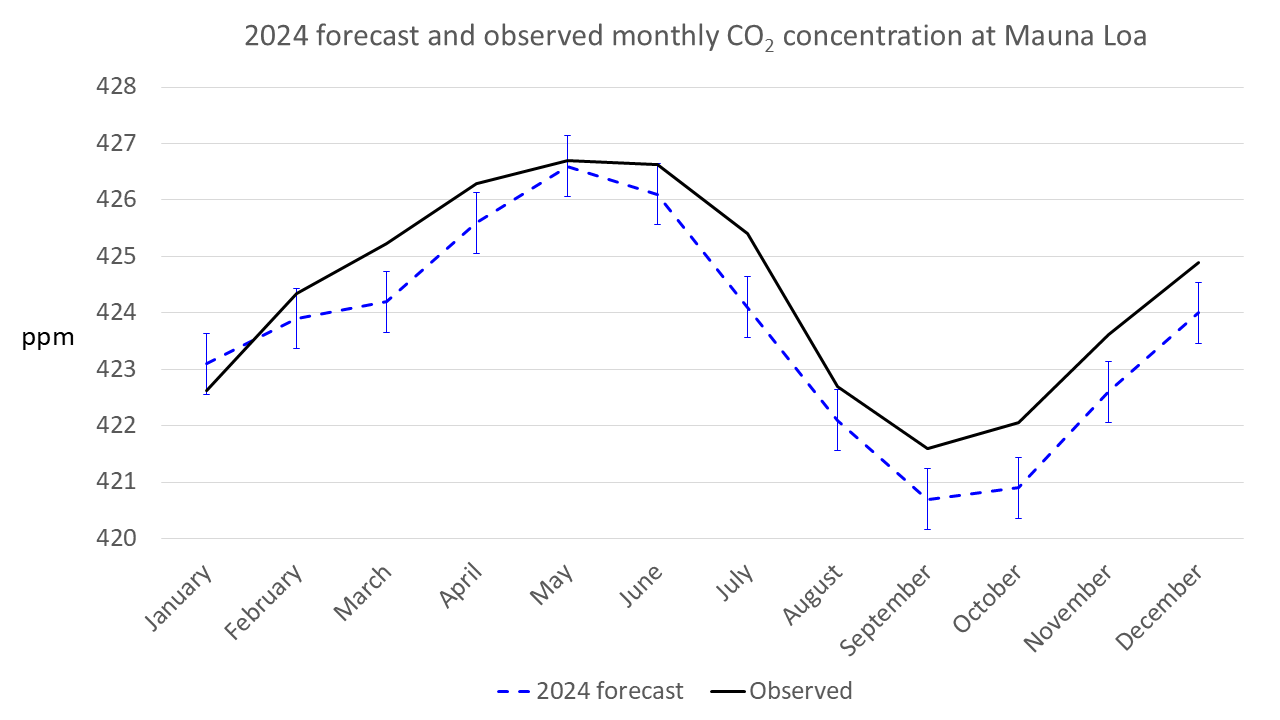
Figure 8. Comparison of Met Office forecasts of monthly CO2 concentrations in 2024 at Mauna Loa (dashed blue line) with measurements for 2024 (solid black line) from the Scripps Institution for Oceanography UC San Diego. The vertical blue lines show the forecast uncertainty range (2 standard deviations).
2024 was the second year since we began our forecasts in 2016 for which the observations were outside the forecast uncertainty range of 2 standard deviations (Table 5). However, unlike 2023, our method for including the effect of ENSO variability still brought the central value of the forecast CO2 rise closer to the observations than if ENSO had been ignored (Figure 9). In all years up to 2022, our method for including the ENSO impact had led to a more accurate CO2 forecast.
Table 4. Forecast and observed monthly average CO2 concentrations at Mauna Loa over 2024. The uncertainty in the forecast values was ±0.5 ppm. Observed monthly averages for January to October are those published by the Scripps Institution for Oceanography at UC San Diego, and those for November and December are provisionally estimated from daily values reported on the Scripps social media channel.
|
Month |
Forecast (ppm) |
Observations (ppm) |
|
January |
423.1 |
422.6 |
|
February |
423.9 |
424.3 |
|
March |
424.2 |
425.2 |
|
April |
425.6 |
426.3 |
|
May |
426.6 |
426.7 |
|
June |
426.1 |
426.6 |
|
July |
424.1 |
425.4 |
|
August |
422.1 |
422.7 |
|
September |
420.7 |
421.6 |
|
October |
420.9 |
422.1 |
|
November |
422.6 |
423.6 |
|
December |
424.0 |
425.0 |
Table 5. Summary of forecast and observed annual CO2 concentrations and rises for 2016 to 2024. Note that observations were not available for December 2022 due to the eruption of the Mauna Loa volcano cutting off power supplies to the observatory, so for 2022 the comparison of forecast and observed mean concentration is given for January-November, and the forecast and observed increases are calculated relative to the January-November mean for 2021. For 2020, both the original forecast and the updated forecast accounting for the Covid-related emissions reductions are shown.
|
Year |
Forecast CO2 increase from previous year (ppm) |
Observed CO2 increase from previous year (ppm) |
Forecast annual mean CO2 concentration (ppm) |
Observed annual mean CO2 concentration (ppm) |
|
2024 |
2.84 ± 0.54 |
3.58 |
423.6 ± 0.5 |
424.3 |
|
2023 |
1.97 ± 0.52 |
2.57 |
420.2 ± 0.5 |
420.8 |
|
2022 |
2.14 ± 0.52 |
2.11 |
418.3 ± 0.5 |
418.2 |
|
2021 |
2.29 ± 0.55 |
2.10 |
416.3 ± 0.6 |
416.1 |
|
2020 (updated |
2.48 ± 0.57 |
2.52 |
414.0 ± 0.6 |
414.0 |
|
2020 (original) |
2.74 ± 0.57 |
2.52 |
414.2 ± 0.6 |
414.0 |
|
2019 |
2.74 ± 0.58 |
2.90 |
411.3 ± 0.6 |
411.5 |
|
2018 |
2.29 ± 0.59 |
2.00 |
408.9 ± 0.6 |
408.6 |
|
2017 |
2.46 ± 0.61 |
2.31 |
406.8 ± 0.6 |
406.6 |
|
2016 |
3.15 ± 0.53 |
3.39 |
404.5 ± 0.6 |
404.3 |
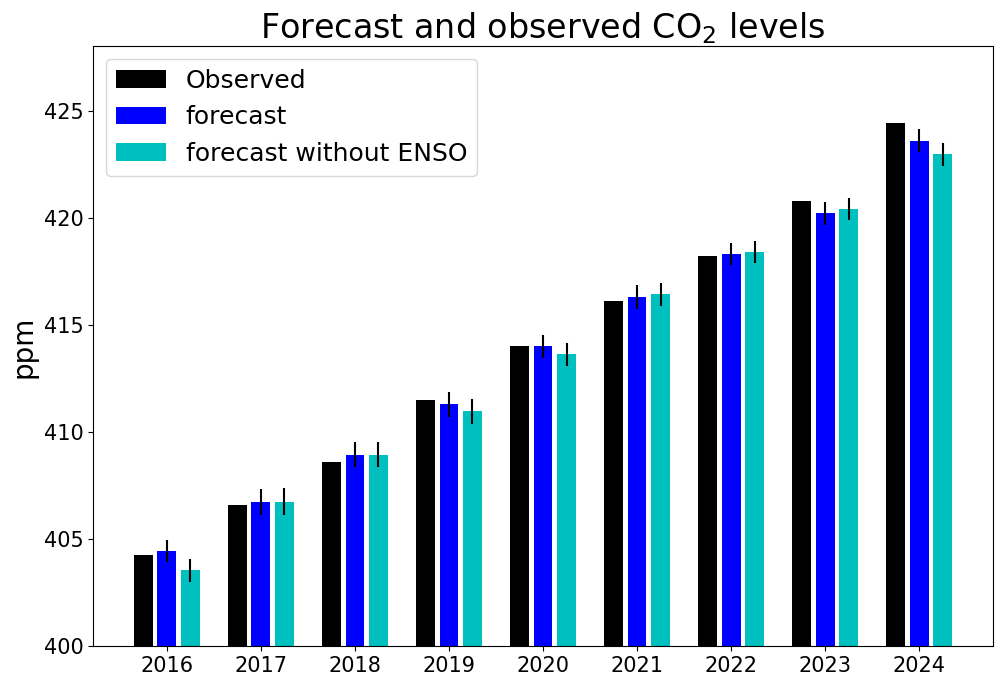
Figure 9. Observed (black) and forecast (dark blue) annual average CO2 concentrations for 2016 to 2024, and re-forecast values based on emissions alone, without the effects of ENSO (light blue). Thin black lines show the forecast uncertainty range (2 standard deviations).
Note: definitions of annual CO2 rise, increment and growth rate
We define the annual CO2 rise or annual increment for a particular year as the difference in annual average concentration for that calendar year and that of the previous calendar year. This is different to the definition of annual 'growth rate' as published by NOAA which is the average change across an individual calendar year.
Acknowledgements
This work is supported by the Met Office Hadley Centre Climate Programme funded by DSIT.
Published 17th January 2025



